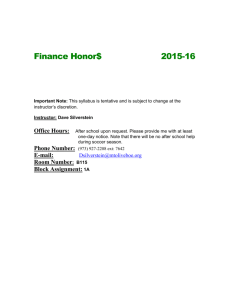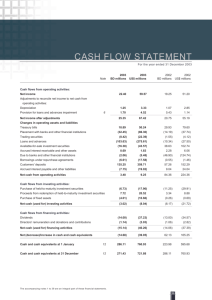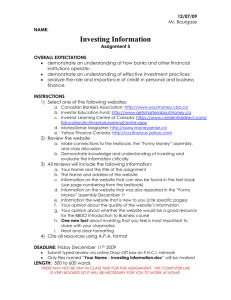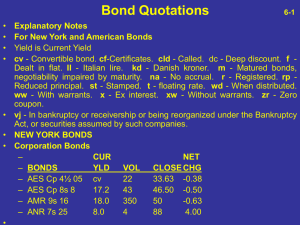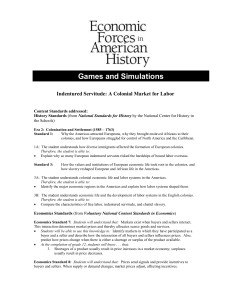Security Analysis and Portfolio Management FIN-321-TE
advertisement
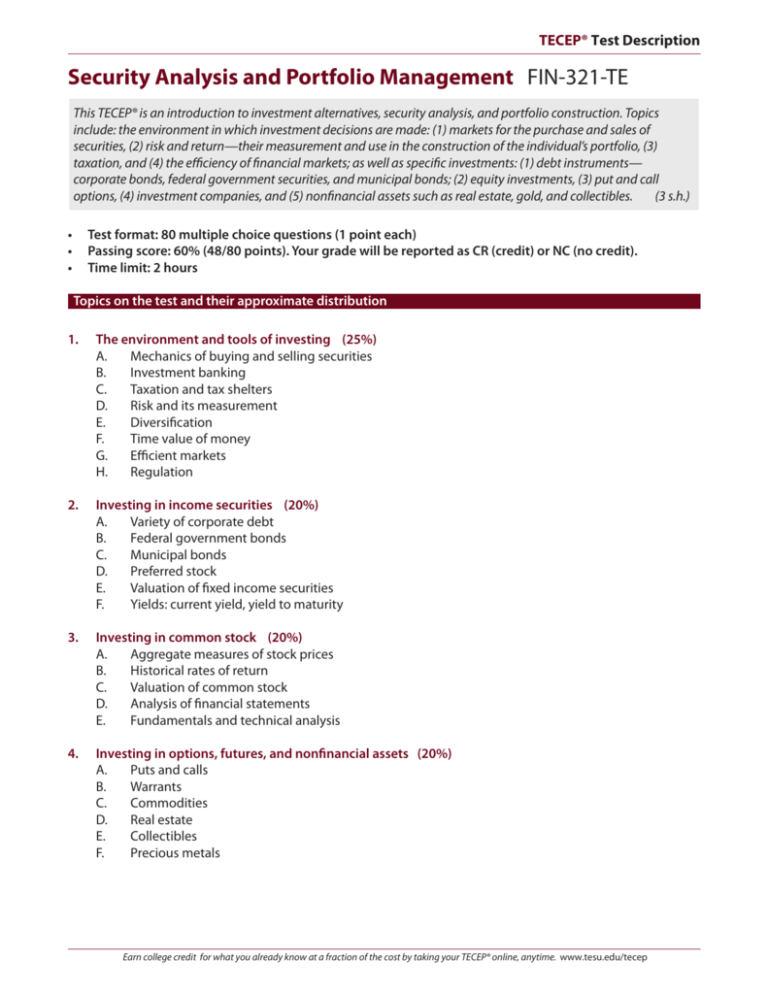
TECEP® Test Description Security Analysis and Portfolio Management FIN-321-TE This TECEP® is an introduction to investment alternatives, security analysis, and portfolio construction. Topics include: the environment in which investment decisions are made: (1) markets for the purchase and sales of securities, (2) risk and return—their measurement and use in the construction of the individual’s portfolio, (3) taxation, and (4) the efficiency of financial markets; as well as specific investments: (1) debt instruments— corporate bonds, federal government securities, and municipal bonds; (2) equity investments, (3) put and call options, (4) investment companies, and (5) nonfinancial assets such as real estate, gold, and collectibles. (3 s.h.) • • • Test format: 80 multiple choice questions (1 point each) Passing score: 60% (48/80 points). Your grade will be reported as CR (credit) or NC (no credit). Time limit: 2 hours Topics on the test and their approximate distribution 1. The environment and tools of investing (25%) A. Mechanics of buying and selling securities B. Investment banking C. Taxation and tax shelters D. Risk and its measurement E.Diversification F. Time value of money G. Efficient markets H.Regulation 2. Investing in income securities (20%) A. Variety of corporate debt B. Federal government bonds C. Municipal bonds D. Preferred stock E. Valuation of fixed income securities F. Yields: current yield, yield to maturity 3. Investing in common stock (20%) A. Aggregate measures of stock prices B. Historical rates of return C. Valuation of common stock D. Analysis of financial statements E. Fundamentals and technical analysis 4. Investing in options, futures, and nonfinancial assets (20%) A. Puts and calls B.Warrants C.Commodities D. Real estate E.Collectibles F. Precious metals Earn college credit for what you already know at a fraction of the cost by taking your TECEP® online, anytime. www.tesu.edu/tecep TECEP® Test Description 5. Investment companies and the construction of diversified portfolios (15%) A. Closed-end investment companies B. Mutual funds C. Returns earned by investment companies Study materials Either text will provide adequate preparation, as will most college-level texts in this subject. Gup, Benton E. The Basics of Investing. Current edition. New York: John Wiley Mayo, Herbert B. Investments: An Introduction. Current edition. Eagan, MN: South-Western/Cengage Sample questions 1. A liquid asset may a. be converted into cash b. be converted into cash with little chance of loss c. not be converted into cash d. not be converted without loss 2. A negatively-sloped yield curve suggests that a. short-term rates exceed long-term rates, and the Federal Reserve is following a tight monetary policy b. short-term rates exceed long-term rates, and the Federal Reserve is following an easy monetary policy c. long-term rates exceed short-term rates, and the Federal Reserve is following a tight monetary policy d. long-term rates exceed short-term rates, and the Federal Reserve is following an easy monetary policy 3. What does the market price of a bond depend on? a. The coupon rate and terms of the indenture b. The coupon rate and maturity date c. The terms of the indenture, and maturity date d. The coupon rate, terms of the indenture, and maturity date 4. While bond prices fluctuate, a. yields are constant b. coupons are constant c. the spread between yields is constant d. short-term bond prices fluctuate even more 5. If interest rates rise, the price of preferred stock a. is not affected b. rises c. falls d. may rise or fall Earn college credit for what you already know at a fraction of the cost by taking your TECEP® online, anytime. www.tesu.edu/tecep TECEP® Test Description 6. Which of the following is true of municipal government debt? a. It pays more interest than corporate debt. b. It is often purchased by individuals with high incomes. c. It is exempt from estate taxation. d. It is not subject to interest rate risk. 7. The use of financial leverage by a firm may be measured by the a. ratio of debt to total assets b. firm’s beta coefficient c. firm’s retention of earnings d. ratio of the price of the firm’s stock price to its earnings 8. Which of the following is an example of a depreciable asset? a. Land b. Cash c. Accounts receivable d. Equipment 9. As the debt ratio increases, a. fewer assets are debt-financed, and the ratio of debt-to-equity increases b. fewer assets are debt-financed, and the ratio of debt-to-equity decreases c. more assets are debt-financed, and the ratio of debt-to-equity increases d. more assets are debt-financed, and the ratio of debt-to-equity decreases 10. The net asset value of a mutual fund investing in stock rises with a. higher stock prices b. lower equity values c. an increased number of shares d. increased liabilities 11. What do activity ratios measure? a. How rapidly assets flow through the firm b. How frequently the firm’s stock is traded c. The employee turnover rate d. The profitableness of accounts receivable 12. What is a call? a. An option to sell stock at a specified price b. An option to buy stock at a specified price c. An option to sell stock on a specified date d. An option to buy stock on a specified date 13. Which of the following is on the horizontal axis of the Security Market Line? a. Standard deviation b. Beta c. Expected return d Required return Earn college credit for what you already know at a fraction of the cost by taking your TECEP® online, anytime. www.tesu.edu/tecep TECEP® Test Description 14. You own a large orange grove and will be harvesting from November through April. To hedge against price risks you should a. sell orange juice contracts with a November delivery b. buy orange juice contracts with a November delivery c. sell orange juice contracts with delivery dates between November and April d. buy orange juice contracts with delivery dates between November and April 15. Financial leverage may increase a corporation’s risk because a. operating income may stabilize b. the firm has fixed obligations to meet c. more common stock is outstanding d. dividends must be paid 16. What is the value of a call on the expiration date, if on that date the price of the stock is $25 and the exercise price is $26? a. $-1 b. $0 c. $1 d. $25 17. Equity does NOT include a. cash and paid-in capital b. common stock and paid-in capital c. paid-in capital and retained earnings d. common stock, paid-in capital and retained earnings 18. What is the price of a stock estimated to pay a dividend of $.60 next year, if the dividend growth rate is 5% and the appropriate discount rate is 8%? a. $18 b. $19 c. $20 d. $21 19. Corporate bond indenture agreements often specify each of the following EXCEPT a. bond call provisions b. sinking fund requirements c. restrictions on the corporation’s divided payments d. assets on which debenture issues are collaterized 20. If you were confident that the price of stock X would drop dramatically within two months, which of the following investment transactions would yield the highest return on your investment? a. Purchase stock X b. Sell stock X short c. Purchase a call on stock X d. Purchase a put on stock X 21. Which of the following choices describes a traditional IRA? a. A tax-deferred retirement account for individuals not covered by a corporate pension plan b. A taxable retirement account for individuals not covered by a corporate pension plan c. A means to generate tax-free income d. A means to increase current income Earn college credit for what you already know at a fraction of the cost by taking your TECEP® online, anytime. www.tesu.edu/tecep TECEP® Test Description Answers to sample questions 1. b 2. a 12. b 13. b 3. d 4. b 5. c 14. c 15. b 16. b 6. b 7. a 8. d 9. c 10. a 17. a 18. c 19. d 20. d 21. a 11. a Earn college credit for what you already know at a fraction of the cost by taking your TECEP® online, anytime. www.tesu.edu/tecep

